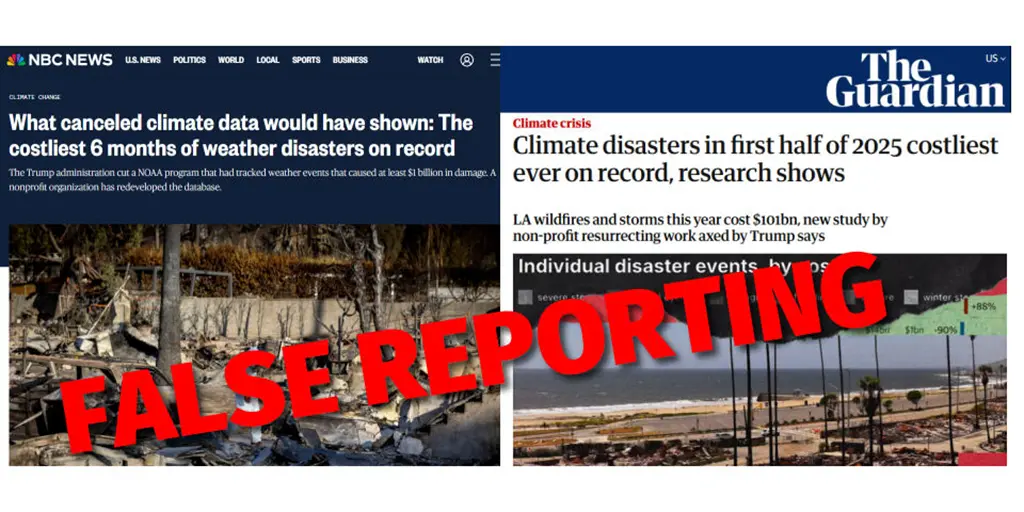Copyright Watts Up With That

From ClimateREALISM By H. Sterling Burnett Multiple mainstream media outlets published stories this week uncritically publicizing the claims of a climate change interest group, Climate Central (CC). According to CC, climate change has caused higher weather disaster costs in the United States this year than ever in history – or at least since 1980, which is as far as the records CC uses go back. These claims are false. While the costs of extreme weather events and wildfires were high in early 2025, there are no trends that indicate climate change is responsible. Rather, higher populations, increased development in disaster prone areas, poor water management, and human evil in the form of arson, were the cause of the abnormally high disaster costs. The Guardian’s headline on the high costs from natural disasters in the first six months of 2025 directly attributed it to climate change, “Climate disasters in first half of 2025 costliest ever on record, research shows.” NBC News’s story took a shot at the Trump administration as well as hyping a climate connection to the 2025 mid-year disaster cost totals, writing, “What canceled climate data would have shown: The costliest 6 months of weather disasters on record.” The tenor of The Guardian, NBC, and other outlets covering CC’s disaster cost report was nearly universal. Climate change resulted in worse weather disasters and higher costs in early 2025 than ever before, a fact that would have been missed absent CC’s work since President Donald Trump cut funding for the National Oceanic and Atmospheric Administration program, which has previously monitored such costs. Per The Guardian: The first half of 2025 was the costliest on record for major disasters in the US, driven by huge wildfires in Los Angeles and storms that battered much of the rest of the country, according to a climate non-profit that has resurrected work axed by Donald Trump’s administration that tracked the biggest disasters. In the first six months of this year, 14 separate weather-related disasters that each caused at least $1bn in damage hit the US, the Climate Central group has calculated. In total, these events cost $101bn in damages – lost homes, businesses, highways and other infrastructure – a toll higher than any other first half of a year since records on this began in 1980. As NBC News wrote: The first half of this year was the costliest ever recorded for weather and climate disasters in the United States, according to an analysis published Wednesday by the nonprofit organization Climate Central. It is information that the public might never have learned: This spring, the Trump administration cut the National Oceanic and Atmospheric Administration program that had tracked weather events that caused at least $1 billion in damage. The researcher who led that work, Adam Smith, left NOAA over the decision. To be clear, Climate Central is not an objective authority on the causes and consequences of climate change, or a neutral party regarding proposed solutions. Rather, it was created and exists solely to produce and promote material blaming human activities for causing climate change resulting in catastrophic consequences that threaten human life, and to promote government enforced solutions that limit fossil fuel use. Leaving aside the motives of the organization that produced the report, the news coverage of the report was inaccurate from the start. The stories ignore the history of natural disasters in the regions that have been impacted this year, the demographic changes that have resulted in the higher costs, and, most importantly, the lack of any long-term discernable changes in weather patterns and the incidences and severity of extreme weather events for the areas affected. Looking at where the disasters occurred in the first half of this year, from CC’s own tracking we find the weather events were tornadoes that occurred during typical tornado season stretching from Texas through the plains to the upper mid-west. This area of the country is commonly referred to as “tornado alley” because such events are so common there during the spring and early summer. So, nothing unusual there. What critically undermines the CC report and the media’s suggestion that the rising cost of tornadoes is due to climate change is the fact, as explored in Climate Realism, here, here, and here, for example, that neither the number, frequency, nor severity of tornadoes has increased as the Earth has slightly warmed. Other events include flooding in areas of the country historically known for spring flooding as a result of snowmelt and severe spring snowstorms – many of the areas are popular riverfront towns or communities. Climate Realism has repeatedly debunked media claims that flooding is getting worse – data show it isn’t. If flooding is not becoming more frequent or severe, climate change can’t be causing higher costs related to flooding. Indeed, even the Intergovernmental Panel on Climate Change has identified no worsening trend in floods or tornadoes that it can attribute to climate change. Finally, more than 60 percent of the $101 billion disaster costs that CC says resulted from climate change altered weather events are attributable to just a single event: the January 2025 wildfires that decimated a large swath of Los Angeles. The Los Angeles fires were horrific, of a kind not experienced there in recent history, but not unusual historically. The huge damage was a result of a combination of factors, good seasonal rainfall in recent years creating lush natural growth combined with and regular lawn and tree watering in wealthy enclaves, followed by a severe drought, creating conditions for a wildfire, and strong Santa Anna winds to drive a fire quickly across the landscape once started (once again a natural feature of the area). With these conditions, all that was needed was a spark, which a perverse arsonist provided. Once the fire started, winds drove it quickly across a tinder dry landscape and firefighters found a shortage of water in reservoirs as a result of political decisions made by the state government. Los Angeles is not warmer than is was in the 1950s and precipitation has actually increased slightly in the region since 1895. Despite climate alarmists and advantage seeking, virtue signaling Democratic politicians attempting to blame climate change for the fire and its severity, the evidence indicates it had nothing to do with it. If climate conditions haven’t change appreciably across the United States, in the sense that the more extreme weather patterns are emerging, the question is, why have costs related to weather disasters gone up so much in nominal dollars? Keep in mind that in inflation adjusted dollars as a percentage of GDP, the costs of natural disasters have fallen over time. (see the figure, below) As should be obvious to any honest observer exercising the least bit of common sense, the reason for rising disaster costs is clear, the expanding bullseye effect. As Climate Realism has explored in dozens of articles previously, with more people moving into ecologically/climatically desirable locations, locations prone to natural disasters, erecting more homes, businesses, and related structures and infrastructure, property has gone up dramatically in value overtime. When a disaster like a wildfire (in this case an arson started wildfire) strikes, more people and property is impacted and related costs are higher. Climate Realism discussed this very point in articles linked, here, here, and here, to take but a few examples. Quite simply, when a hurricane hits Miami or Galveston now, there are more buildings and structures to destroy at those locations than there was 100 years ago. One can acknowledge that CC is right, natural disasters are imposing higher costs in nominal dollars now than they did in the past, without jumping to the completely unfounded claim that climate change is the cause. Legitimate journalists and honest news outlets, as NBC News and The Guardian purport to be, should check their facts before parroting the false rantings of a climate lobbing group as the truth. Misleading, false alarm stories like these are perhaps why trust in the media is low and falling. H. Sterling Burnett H. Sterling Burnett, Ph.D., is the Director of the Arthur B. Robinson Center on Climate and Environmental Policy and the managing editor of Environment & Climate News. In addition to directing The Heartland Institute’s Arthur B. Robinson Center on Climate and Environmental Policy, Burnett puts Environment & Climate News together, is the editor of Heartland’s Climate Change Weekly email, and the host of the Environment & Climate News Podcast.



